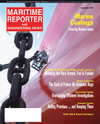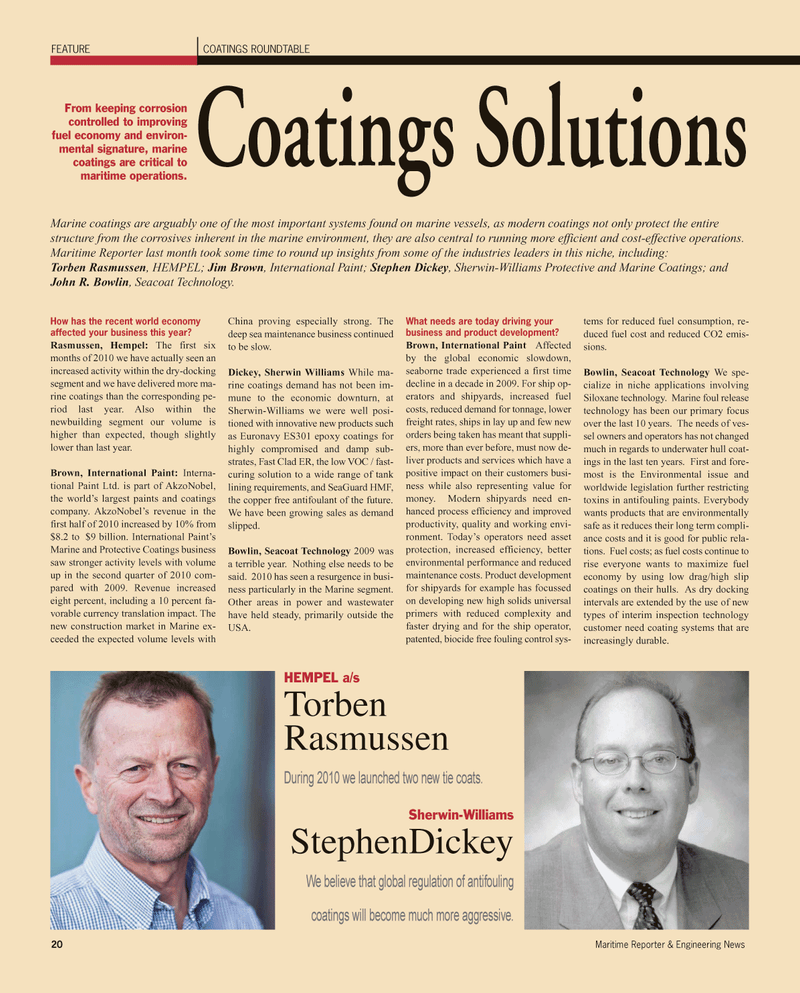
Page 20: of Maritime Reporter Magazine (September 2010)
Marine Propulsion Edition
Read this page in Pdf, Flash or Html5 edition of September 2010 Maritime Reporter Magazine
20 Maritime Reporter & Engineering News
FEATURE COATINGS ROUNDTABLE
Coatings Solutions
From keeping corrosion controlled to improving fuel economy and environ- mental signature, marine coatings are critical to maritime operations.
How has the recent world economy affected your business this year?
Rasmussen, Hempel: The first six months of 2010 we have actually seen an increased activity within the dry-docking segment and we have delivered more ma- rine coatings than the corresponding pe- riod last year. Also within the newbuilding segment our volume is higher than expected, though slightly lower than last year.
Brown, International Paint: Interna- tional Paint Ltd. is part of AkzoNobel, the world’s largest paints and coatings company. AkzoNobel’s revenue in the first half of 2010 increased by 10% from $8.2 to $9 billion. International Paint’s
Marine and Protective Coatings business saw stronger activity levels with volume up in the second quarter of 2010 com- pared with 2009. Revenue increased eight percent, including a 10 percent fa- vorable currency translation impact. The new construction market in Marine ex- ceeded the expected volume levels with
China proving especially strong. The deep sea maintenance business continued to be slow.
Dickey, Sherwin Williams While ma- rine coatings demand has not been im- mune to the economic downturn, at
Sherwin-Williams we were well posi- tioned with innovative new products such as Euronavy ES301 epoxy coatings for highly compromised and damp sub- strates, Fast Clad ER, the low VOC / fast- curing solution to a wide range of tank lining requirements, and SeaGuard HMF, the copper free antifoulant of the future.
We have been growing sales as demand slipped.
Bowlin, Seacoat Technology 2009 was a terrible year. Nothing else needs to be said. 2010 has seen a resurgence in busi- ness particularly in the Marine segment.
Other areas in power and wastewater have held steady, primarily outside the
USA.
What needs are today driving your business and product development?
Brown, International Paint Affected by the global economic slowdown, seaborne trade experienced a first time decline in a decade in 2009. For ship op- erators and shipyards, increased fuel costs, reduced demand for tonnage, lower freight rates, ships in lay up and few new orders being taken has meant that suppli- ers, more than ever before, must now de- liver products and services which have a positive impact on their customers busi- ness while also representing value for money. Modern shipyards need en- hanced process efficiency and improved productivity, quality and working envi- ronment. Today’s operators need asset protection, increased efficiency, better environmental performance and reduced maintenance costs. Product development for shipyards for example has focussed on developing new high solids universal primers with reduced complexity and faster drying and for the ship operator, patented, biocide free fouling control sys- tems for reduced fuel consumption, re- duced fuel cost and reduced CO2 emis- sions.
Bowlin, Seacoat Technology We spe- cialize in niche applications involving
Siloxane technology. Marine foul release technology has been our primary focus over the last 10 years. The needs of ves- sel owners and operators has not changed much in regards to underwater hull coat- ings in the last ten years. First and fore- most is the Environmental issue and worldwide legislation further restricting toxins in antifouling paints. Everybody wants products that are environmentally safe as it reduces their long term compli- ance costs and it is good for public rela- tions. Fuel costs; as fuel costs continue to rise everyone wants to maximize fuel economy by using low drag/high slip coatings on their hulls. As dry docking intervals are extended by the use of new types of interim inspection technology customer need coating systems that are increasingly durable.
Marine coatings are arguably one of the most important systems found on marine vessels, as modern coatings not only protect the entire structure from the corrosives inherent in the marine environment, they are also central to running more efficient and cost-effective operations.
Maritime Reporter last month took some time to round up insights from some of the industries leaders in this niche, including:
Torben Rasmussen, HEMPEL; Jim Brown, International Paint; Stephen Dickey, Sherwin-Williams Protective and Marine Coatings; and
John R. Bowlin, Seacoat Technology.
HEMPEL a/s
Torben
Rasmussen
During 2010 we launched two new tie coats.
Sherwin-Williams
StephenDickey
We believe that global regulation of antifouling coatings will become much more aggressive.

 19
19

 21
21
